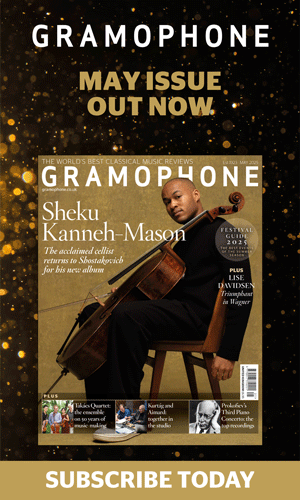Dohnányi's Suite for Orchestra, Op 19: a guide to the greatest recordings
Richard Bratby
Thursday, April 17, 2025
From Proms sensation to forgotten gem, this once-popular orchestral work's revival on record offers new life – despite its absence from the concert stage

Musical fashions can be fickle. Ireland’s Piano Concerto, Franck’s Symphonic Variations, Rawsthorne’s Street Corner: we all have our personal list of pieces that were popular for years (and even decades) until suddenly, unaccountably, they weren’t. Mine is headed by the glorious Suite in F sharp minor, Op 19, by Ernő Dohnányi: a large-scale orchestral work that was such a smash at the 1913 Proms that it had to be repeated by popular demand. Reporting on that UK premiere, the critic of The Queen concluded that the Suite ‘has come to stay’.
So what happened? Originally titled Suite romantique and premiered in Budapest in February 1910, its four movements (a theme and variations, a peppery Scherzo, a Romanze and a final Rondo) are like a particularly genial concerto for orchestra – poetic, playful and drenched in a kaleidoscope of late-Romantic colours. The Suite received 13 performances at the Proms between 1913 and 1957 and then just vanished. Thank goodness, then, for recordings – indeed, the work’s popularity on disc appears to have grown in inverse proportion to its presence in the concert hall.
First off the mark, in 1928, was Frederick Stock in Chicago. As you’d expect, the dynamic range is limited, and there are cuts (most disappointingly in the Romanze, where the delicious, humoreske-like central interlude is simply omitted). But there’s something magical about hearing an orchestral sound from the era in which this music was composed, complete with plangent oboes and easy, sensuous string portamentos – a stylistic detail that no subsequent recording attempts to emulate.
Dohnányi had a loyal following in the US (where he spent the last years of his life in exile), and I was sorry that I couldn’t obtain the recordings by Alfred Wallenstein in Los Angeles in 1949 (Decca/Brunswick, 11/53) and Milton Katims in Seattle in 1964 (Turnabout, 2/77); or for that matter Malcolm Sargent and the LSO (Columbia, 5/51). So it’s straight on to Sargent’s second recording, with the Royal Philharmonic Orchestra (HMV, 11/62), and in every regard but one, it’s superb. The horns are heroic in the Scherzo, and the strings are silken and full-bodied. It’s all captured in bright, clear early stereo, highlighting Sargent’s astonishingly close attention to the letter of the score.
Alas, Sargent takes the finale (and few composers since Haydn have created wittier finales than Dohnányi) at a steady jog-trot, when really it needs to fizz. Sargent conducted the Suite several times at the Proms; perhaps he was still overcompensating for the Royal Albert Hall. No such problem with Tamás Vásáry and the Budapest Symphony Orchestra (Hungaroton, 1996), who take the Rondo at a bristling (but never breathless) pace.
This is our first all-Hungarian team, and I think you can tell – not so much in specific details (though the bassoons and timpani are irrepressible), as in the way that orchestra and conductor move and breathe together. For once, it feels like the players have lived with the music. It sings, it dances, and I have to admit that it’s a personal favourite.
It certainly outclasses the two most recent recordings. In fairness, there’s much to be enjoyed from JoAnn Falletta in Buffalo (Naxos, 2010) and Roberto Paternostro’s ORF Symphony Orchestra (Capriccio, 10/21) but there’s a certain homogeneity – a lack of paprika – in Falletta’s reading, while Paternostro’s Viennese orchestra feels altogether too stiff: Dohnányi on parade, in full dress uniform. Those swashbuckling castanets in the finale are practically inaudible.
Happily, we have two complete, characterful and beautifully played alternatives, both in excellent digital sound. Mathias Bamert and the BBC Philharmonic (Chandos, 9/99) have long been my go-to interpreters. Bright, vivid and thrillingly virtuosic, their account of the finale is easily the most exciting on record.
But Domonkos Héja and the Danubia Symphony Orchestra (Warner Classics, 4/06) are another all-Hungarian line-up, and – well, I hate to indulge national clichés but there’s an earthiness and a rhythmic bite in their playing that makes Dohnányi’s colours glow and his flavours tingle on the palate. The Romanze is positively balletic, and whenever Dohnányi opens one of his great sunset vistas, they find a lyricism that goes straight to the heart of this wonderful, neglected music. Next stop, the concert hall? Here’s hoping, but either of these will do very well in the meantime.
Recommended recording

Danubia Symphony Orchestra / Domonkos Héja
Warner Classics
Bamert and the BBC Philharmonic run them close, but Héja and his Budapest‑based orchestra bring a zest and a sense of style that embraces both the playfulness and the passion of this enchanting work.













